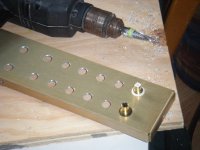Don't use DC!
The amp requires both halves of the AC wave to function properly. It would take some good modding effort to get it to run on DC. There are multiple reasons for its demand for AC that can be read in the O2 Design Process article, section 2-4, and 2-20 to 2-23. Also, the amp needs more like 13.4V+ which the Triad 12V AC transformer supplies when the household supply is over 108V... though useless in your land. DC adapters usually measure right about their rating, so even after mods the amp might not even turn on unless you're running about 14V. The battery integration and charging design would also need a good rework for a DC supply.
P. P. S. For the sake of testing, while I don't have a proper power supply, can I use 12V DC supply?
The amp requires both halves of the AC wave to function properly. It would take some good modding effort to get it to run on DC. There are multiple reasons for its demand for AC that can be read in the O2 Design Process article, section 2-4, and 2-20 to 2-23. Also, the amp needs more like 13.4V+ which the Triad 12V AC transformer supplies when the household supply is over 108V... though useless in your land. DC adapters usually measure right about their rating, so even after mods the amp might not even turn on unless you're running about 14V. The battery integration and charging design would also need a good rework for a DC supply.
Last edited:
O2 Enclosure
Though the O2 itself is fantastic, I'm not to keen on the enclosures you can get off the shelf, so to speak. I had the clean lines of Apple's products in mind when I penned this modular desktop case.
This is a cardboard mock-up just to make sure the design & measurements are OK...
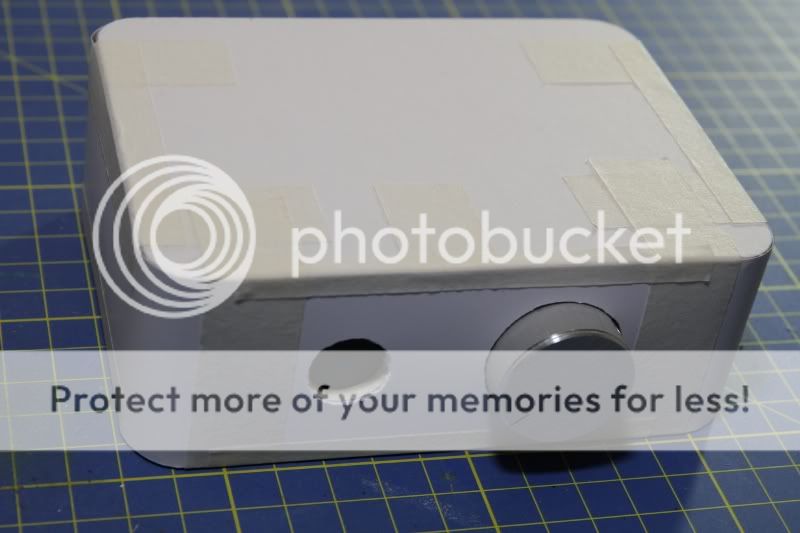
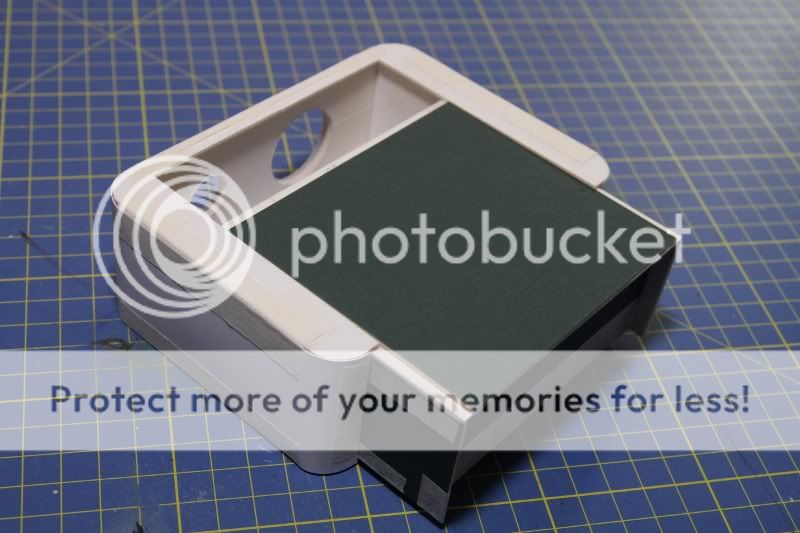
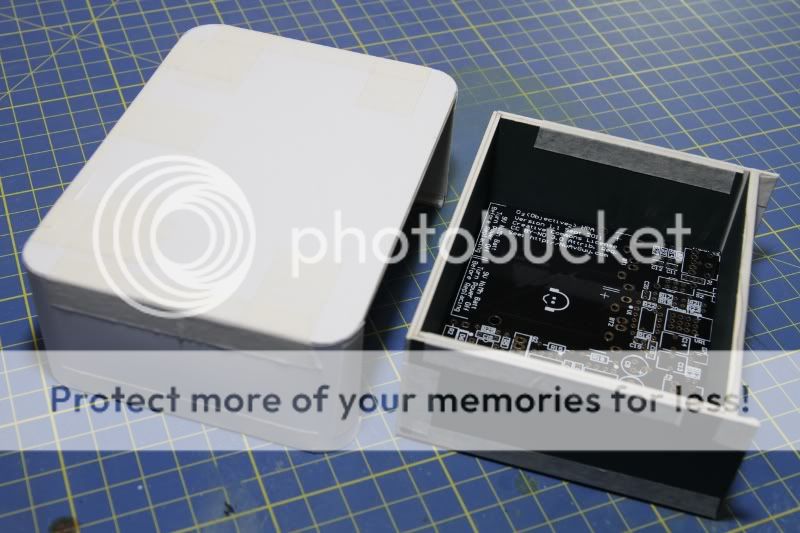
pcb is to be seated the wrong way round, with only the volume and 1/4" jack plug to the front.
Hope you like!
Paul.
Though the O2 itself is fantastic, I'm not to keen on the enclosures you can get off the shelf, so to speak. I had the clean lines of Apple's products in mind when I penned this modular desktop case.
This is a cardboard mock-up just to make sure the design & measurements are OK...



pcb is to be seated the wrong way round, with only the volume and 1/4" jack plug to the front.
Hope you like!
Paul.
Last edited:
Paul,
That's a pretty good design. I like the looks of what you've done - as well as moving the input, the power feed and the gain / power buttons to the rear. A pretty sleek design, actually.
As far as "off the shelf" cases go, I was thinking of basically just cloning the size of the metal case and building my skeleton out of a thin luan plywood. I'd then apply a nice veneer over the luan for a stained and polyurethane finish. This would allow me to not have to de-solder and re-solder any of the board components. While this would still maintain the "busy" look on the front panel, it would still keep the option open for using one of the front plates that are circling around from one of the sources. Also, I could add a top "vent" and apply some mesh so the amp could breathe, if needed.
Again, that's just some thoughts that I had. Finding time is another task to carry such thoughts out.
That's a pretty good design. I like the looks of what you've done - as well as moving the input, the power feed and the gain / power buttons to the rear. A pretty sleek design, actually.
As far as "off the shelf" cases go, I was thinking of basically just cloning the size of the metal case and building my skeleton out of a thin luan plywood. I'd then apply a nice veneer over the luan for a stained and polyurethane finish. This would allow me to not have to de-solder and re-solder any of the board components. While this would still maintain the "busy" look on the front panel, it would still keep the option open for using one of the front plates that are circling around from one of the sources. Also, I could add a top "vent" and apply some mesh so the amp could breathe, if needed.
Again, that's just some thoughts that I had. Finding time is another task to carry such thoughts out.
Well, I managed to miss the front plate group buy, horribly.
So I'm thinking of DIY options and also alternative enclosure options. This could be particularly useful also to desktoppers loking to find a cheaper way to do back plates as it is a little pricey all in all.
Perhaps this merits a separate thread. Someone searching for such info in this main thread could end up being something of a boor. I can also see this thread turning in to a mega-thread which would make it even worse. The T50rp Fostex mod thread is practically unusable for that reason.
Anyone got any knowledge on, for example, hole-punching the supplied, plain front and back plates that come with the standard enclosure? It's not something I've ever done myself before. Perhaps the kit needed for it is too expensive. Perhaps a standard hand-held drill and some directions on drill bits would be enough, with vice/holder advice.
Also, I'd be very interested in stenciling/marking options. How could one go about marking the holes appropriately (power, gain etc) and perhaps also robustly so that they don't rub off so soon. I know nothing of this either but I imagine some diyaudio folks might be clued up.
Alternative materials? MDF a good idea?
Any takers?
So I'm thinking of DIY options and also alternative enclosure options. This could be particularly useful also to desktoppers loking to find a cheaper way to do back plates as it is a little pricey all in all.
Perhaps this merits a separate thread. Someone searching for such info in this main thread could end up being something of a boor. I can also see this thread turning in to a mega-thread which would make it even worse. The T50rp Fostex mod thread is practically unusable for that reason.
Anyone got any knowledge on, for example, hole-punching the supplied, plain front and back plates that come with the standard enclosure? It's not something I've ever done myself before. Perhaps the kit needed for it is too expensive. Perhaps a standard hand-held drill and some directions on drill bits would be enough, with vice/holder advice.
Also, I'd be very interested in stenciling/marking options. How could one go about marking the holes appropriately (power, gain etc) and perhaps also robustly so that they don't rub off so soon. I know nothing of this either but I imagine some diyaudio folks might be clued up.
Alternative materials? MDF a good idea?
Any takers?
Last edited:
Keep in mind, one vendor here in the U.S. will be offering front plates at the end of December for about $11.00 + shipping. I don't have the link in front of me now, though. But, that would be a whole lot easier than worrying about first using a center punch to mark the aluminum, so your bit doesn't "wander" when you start to drill. The stock aluminum plate itself, is too thick to just "punch" through. One would actually make more of a mess with that process and bend the plate up. I'll find the other link and be back in a bit.
Edit: The plates look like they'll be $10.00 + shipping from JDS Labs. http://www.jdslabs.com/storeDIY.php
According to their shipping options when you place something in the cart, they do ship Internationally.
Edit: The plates look like they'll be $10.00 + shipping from JDS Labs. http://www.jdslabs.com/storeDIY.php
According to their shipping options when you place something in the cart, they do ship Internationally.
Last edited:
Keep in mind, one vendor here in the U.S. will be offering front plates at the end of December for about $11.00 + shipping. I don't have the link in front of me now, though. But, that would be a whole lot easier than worrying about first using a center punch to mark the aluminum, so your bit doesn't "wander" when you start to drill.
Thanks; I did see that but $16 dollars is $16 and also they are marked with "Distributed by JDS labs" which I would like to avoid.
So, I gather that they are drillable though not punchable. What would the drill bits be called? Would I be right in presuming that the center punch is simply hammered?
When using a center punch, you would tap it with a hammer. First, I'd place the aluminum plate on a solid piece of wood so it doesn't warp when you tap it. Making a small impression, will keep your drill bit in the slight divet as you drill a precise hole. As far as drill bits go, you'd have to get a set designed for drilling metal. Some are just for wood and plastics. Any tool store would have the bits - I'm assuming you have access to a drill?
mine  , Solid Rosewood.
, Solid Rosewood.
Top opening, upside down.
Top opening, upside down.
An externally hosted image should be here but it was not working when we last tested it.
Very handy drilling tips, guys, thank you.
I've googled stepped drills and am I right in think that this is a drill bit rather than a drill itself. Also this crazy picture:
Self Starting Stepped Drill (4-20mm : 9 Hole) | Frost Auto Restoration Techniques
...looks like the fellow is just casually holding the material. Would I be flirting with losing a few fingers if I tried that?
I've googled stepped drills and am I right in think that this is a drill bit rather than a drill itself. Also this crazy picture:
Self Starting Stepped Drill (4-20mm : 9 Hole) | Frost Auto Restoration Techniques
...looks like the fellow is just casually holding the material. Would I be flirting with losing a few fingers if I tried that?
Last edited:
mine, Solid Rosewood.
Top opening, upside down.
An externally hosted image should be here but it was not working when we last tested it.
Marvellous.
No you use the drill at a much slower speed, I hold the ABS parts by hand, the aluminium just gets very hot if you go to fast, ideally the best thing is a drill press but For a quick job I just hold it against a block of wood.
I can imagine holding ABS by hand also but aluminium?!?
No you use the drill at a much slower speed, I hold the ABS parts by hand, the aluminium just gets very hot if you go to fast, ideally the best thing is a drill press but For a quick job I just hold it against a block of wood.
if I go slower on the drill press on aluminum it will be cooler?
-joe
Your O2 should be fine. As was discussed a week or so ago here, the regulators are self-protecting and incredibly tough. U5 is the only thing you stressed. Because the O2 has very high power supply immunity (PSRR) it really doesn't care if you run it from unbalanced rails (something that will cause serious problems with some discrete amps). The only thing that changes is one rail will clip before the other but few have headphones that allow pushing the O2 into clipping even on battery power.So is there anything that I should be concerned about from 3-4 hours of running so imbalanced a supply situation before fixing the short?
Those are the only caps directly in the signal path in the O2. Like many audiophile beliefs, there is at least some truth behind capacitors altering the sound. In the O2 Design article I reference Doug Self and Cyril Bateman who have both done fairly extensive capacitor testing. The short version is: Electrolytic, and many ceramic, caps can indeed degrade the performance of audio gear. Film caps designed for coupling, however, generally cannot--especially when used for coupling with no AC voltage across them as they are in the O2. 50 volts is the lowest voltage rating such caps are generally available in.Are C13 and C14 decoupling capacitors?
And kind of off-topic question, but I'd really love to hear the explanation of the design decision. Why choose specifically this cap type for C13/14 and not just use the same small ones as others? I thought all types of caps are pretty much the same at sound frequency. I mean, I know there are "audiophile" caps at 10 dollars per 0.1 uF, but I thought that's rubbish. Am I deriously wrong?
P.S. And why 50V, why so big a margin?
Also, just an FIY, "decoupling capacitors" are used on power supply lines to decouple power supply noise from other components and present a low power supply impedance to components. C17 and C18 are decoupling capacitors in the O2.
Yes, sometimes, but not nearly as often as some audiophiles believe. Output capacitors, which are usually electrolytic, create significant low frequency roll off (which means they can have an AC voltage across them), and operate into much lower impedances (which makes their flaws proportionally much more significant), can be detected in blind listening tests. That's why I'm not a big fan of some headphone amps, such as those from Creek, Pro-Ject, a lot of pro sound gear, etc. They typically use electrolytic output capacitors.Size considerations aside, can a human actually hear a difference?
Thanks for the picture and assistance. I don't have the bandwidth to support novices but some have obviously had great success in building the O2 and having it work perfectly the first time. I'm grateful for the help many here have provided to others.I don't think a step-by-step tutorial is really necessary, even for a novice.
Very nice! I'm sure many of us are looking forward to pics of the fully finished amp.Though the O2 itself is fantastic, I'm not to keen on the enclosures you can get off the shelf, so to speak. I had the clean lines of Apple's products in mind when I penned this modular desktop case.
Also very nice! I'm really impressed at all the time many have put into custom enclosures for the O2. It's flattering many have deemed the electronics worthy of all that labor.mine, Solid Rosewood.
I think I might have cocked things up here a little.
While it plays music beautifully, it's got a massive turn on transient. It registers as +/-0.6VDC on both channels, wether its running on battery or AC, and independent of the pots position.
When idling it sits at a comfortable 2.8mVDC
While it plays music beautifully, it's got a massive turn on transient. It registers as +/-0.6VDC on both channels, wether its running on battery or AC, and independent of the pots position.
When idling it sits at a comfortable 2.8mVDC
@Limp, if it's very brief, that might be normal. If you're trying to use a DMM, all bets are off. With headphones is there a really loud pop or just a "tick"?
Here's my scope result from the O2 Details article where I measured a peak of 0.8 volts. The key is it's only 1.5 milliseconds long. That's about half of a single cycle at 300 hz. So it's not "DC" or "massive" at all, but just like a regular audio signal. An iPod can put out more than that just playing music.
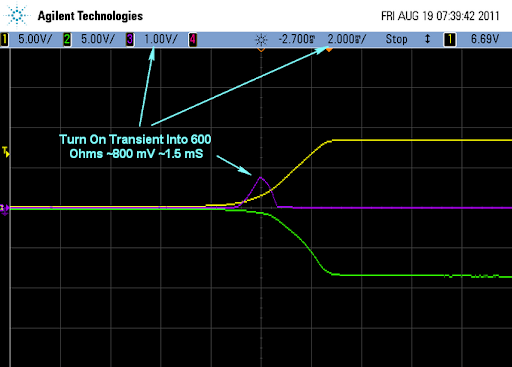
Here's my scope result from the O2 Details article where I measured a peak of 0.8 volts. The key is it's only 1.5 milliseconds long. That's about half of a single cycle at 300 hz. So it's not "DC" or "massive" at all, but just like a regular audio signal. An iPod can put out more than that just playing music.

It's definitely more than a click. With my HD25-1s it's painfully loud. I do not dear to plug in more sensitive headphones.
I realize a DMM isn't the optimal tool for this, but what caught my eye was that it registered both -.6V and +.6V (approximate values, it varied betveen ~.4 and .6, but always symmetrical) when set to capture min/max, and avg. was close to zero.
Is this just a fluke of the Fluke , or does it mean anything?
, or does it mean anything?
I realize a DMM isn't the optimal tool for this, but what caught my eye was that it registered both -.6V and +.6V (approximate values, it varied betveen ~.4 and .6, but always symmetrical) when set to capture min/max, and avg. was close to zero.
Is this just a fluke of the Fluke
Last edited:
- Home
- Amplifiers
- Headphone Systems
- The Objective2 (O2) Headphone Amp DIY Project
